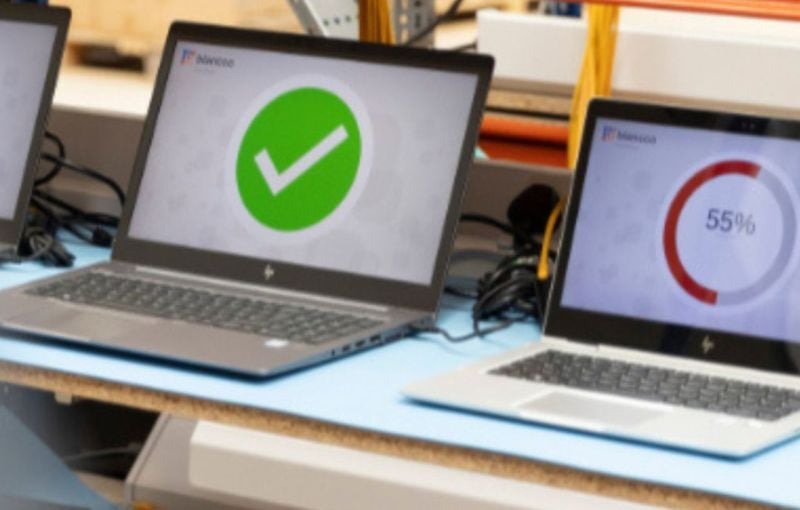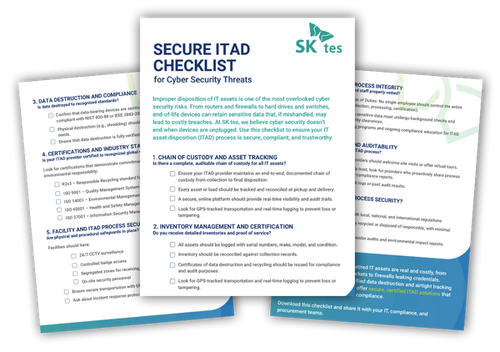October marks Cybersecurity Awareness Month, and while many organizations focus on firewalls, phishing prevention, and endpoint protection, one critical area is often overlooked - the secure retirement of IT equipment. SK Tes urges businesses to think about what happens to their devices when technology is refreshed or employees leave the business and treat end-of-life hardware as a serious cybersecurity and compliance risk.
Jump to section
The Hidden Threat in IT Equipment Disposal
When IT equipment reaches the end of its lifecycle and it is ready for disposal, it’s easy to assume that a factory reset or physical drive removal is enough. But routers, switches, and hard drives can retain sensitive data long after they’ve powered down. Company credentials, network configurations, proprietary data, and even personal health or financial data have been found on dispositioned IT equipment, sometimes resold or dumped without proper and complete sanitization.
Recent breaches highlight the risks:
- Refurbished routers sold online were found to contain corporate data, including credentials and network maps (Resource Reycling)
- A global data leak involving FortiGate firewall devices exposed configuration files and internal network details (Help Net Security)
- In the Netherlands, a man purchased hard drives filled with medical data at a second-hand market, revealing thousands of patient health records (ITpro)
- In the US, a stolen hard drive exposed personal health records for 76,000 patients, violating HIPAA regulations and more examples (HIPPA)
These incidents aren’t uncommon, and they evidence systemic failures in the management of disposed IT assets.

Why Factory Resets of IT Equipment Aren’t Sufficient
Some organizations rely on factory resets to ‘erase’ data. Unfortunately, this method often leaves recoverable traces of data. To completely protect sensitive information, data must be erased using recognized standards like NIST SP 800-88 and IEEE 2882-2022.
- NIST 800-88 outlines three levels of data sanitization: Clear, Purge, and Destroy. Clear uses logical techniques like overwriting, Purge involves cryptographic erasure or degaussing, and Destroy means physical destruction. The standard helps organizations choose the right methods based on data sensitivity, equipment type, and reuse goals.
- IEEE 2883:2022, a newer standard, addresses modern storage technologies like SSDs and NVMe drives. It also defines Clear, Purge and Destruct methods, but with updated guidance for newer devices. Notably, IEEE discourages shredding as a final solution, promoting environmentally sustainable practices and reuse where possible.
Both standards emphasize that verification is essential, data wiping is not enough without proof that the data has been irreversibly removed.
Global Data Regulatory Risks Are Real
Improper disposition of IT assets can lead to serious violations of global data protection laws.
An Overview of Key Data Protection Regulations:
- GDPR (General Data Protection Regulation): Applies to organizations handling EU citizen’s data. Mandates secure data processing and disposal. Breaches can result in fines up to €20 million or 4% of global turnover.
- UKDPR (UK Data Protection Regulation): The UK’s post-Brexit version of GDPR, it governs how personal data is processed and disposed of within the UK. Organizations must ensure that data on retired devices is securely erased to avoid breaches and penalties from the Information Commissioner’s Office (ICO).
- HIPAA (Health Insurance Portability and Accountability Act): US law protecting patient health information. Mishandling PHI, even on discarded devices, can lead to civil and criminal penalties.
- PCI DSS (Payment Card Industry Data Security Standard): Governs how businesses handle cardholder data. Retired devices with stored payment information must be securely wiped or destroyed.
- NIS2 (Network and Information Security Directive): EU directive requiring critical infrastructure operators to manage cybersecurity risks, including data disposal.
- DORA (Digital Operational Resilience Act): EU regulation for financial entities, mandating secure IT asset management and data protection throughout the lifecycle.
Breaching these regulations can result in fines, damage to your business reputation, and harm to customer trust.
A Better Way to Retire IT Equipment with SK Tes
SK Tes offers certified data destruction, secure logistics, and complete audit trails as part of its global IT asset disposition (ITAD) service, ensuring compliance and data security.
To help your business or organization retire IT assets, we are offering a free 8-point Checklist for Secure IT Asset Disposition.
Secure ITAD Checklist for Cyber Security - SK Tes
Prevent cyber security threats, data breaches and regulatory issues.
Access the Secure ITAD Checklist to keep your IT asset disposition (ITAD) process secure and compliant.

This blog is written by:

Tom Hoof, Group IT Director
Tom Hoof is the Group IT Director at SK Tes, a leading global technology and IT lifecycle services firm. With over two decades of experience in enterprise IT strategy, infrastructure, and digital transformation, Tom has been instrumental in driving innovation and operational excellence across the organization. Known for his pragmatic leadership and deep technical insight, he oversees global IT initiatives that align with business goals and future-proof the company’s digital capabilities. Passionate about cybersecurity, cloud architecture, and emerging tech, Tom is a frequent contributor to industry panels and thought leadership forums.
Get in touch with us, contact us.
See how SK Tes can help you today
Contact us to schedule a secure IT asset disposition consultation today.




